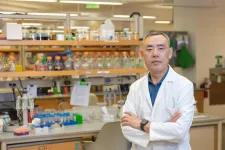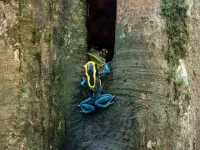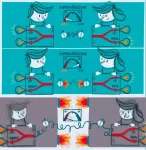(Press-News.org) New research shows the UK's COVID-19 management decisions were based on an outdated pandemic modelling structure and suggests a more resilient approach would have been more effective.
In the initial months of the pandemic, regular updates using graphs showing how the R number was behaving was the mainstay of the Government's strategy for tackling COVID-19.
This type of infection transmission is usually mathematically-based on dividing the population into 'compartments'. Such an approach has been criticised for its limited scope and inability to capture critical factors, such as the effects of testing, contact tracing and isolation. In addition, these existing models tend to look back at what the outcomes were, rather than look forward at future outcomes.
Professor Ashraf Labib, Professor of Operations and Decision Analysis in the Faculty of Business and Law at the University of Portsmouth, is the author of a new paper published this month in the journal of Safety Science. He urges Governments to use a more holistic approach, which provides a much richer modelling and in-depth decision analysis that can lead to better decision making.
Professor Labib has developed a hybrid model - a combination of resilience triangle modelling, which, provides a specific time of 'when' to act and the bowtie modelling that deals with the question of 'how' to act. He then added five guiding principles* which together provide an improved model from which lessons for the future can be learnt.
Professor Labib explains: "Resilience-based modelling with the five proposed principles can enhance public policy decisions. The aim of such modelling is to provide a learning environment on how to absorb failure and provides an opportunity to achieve quick recovery.
"Resilience modelling can offer the answer to 'when' to do things, whereas the bowtie modelling deals with causal analysis and can provide information on the 'how' questions. By combining the two, a balance is achieved in terms of dealing with a disaster, such as the Covid-19 pandemic, at both strategic and operational levels respectively.
"At a strategic level, the phases of prevention of the cause, response and mitigation of the consequences are visualised and strategic milestones can be set accordingly. Whereas, through bowtie modelling more operational details of causal factors and barriers analysis are achieved. Such analysis helps to improve knowledge related to assessing existing barriers and the need for new or improved ones. In addition, the bowtie modelling provides insight to visualise and communicate the complexity of risks in a concise form."
The paper also suggests it is vital that public health simulation exercises are extended to include not just policies related to health, but also include different economic scenarios caused by pandemics.
Professor Labib says: "Given the complex nature of a pandemic and the experiences with COVID-19 in terms of multiple waves, emerging variants and the variety of available vaccines, the main lesson learnt from all of this is to embrace uncertainty rather than to confront it or shy away from it. This is the way we will learn and prepare for future pandemics.
"Resilience as a conceptual idea is profound and considered to have a key role in dealing with disasters such as pandemics. However, there is little research on modelling resilience and integrating it with other approaches in order to systematise its operation. This paper aimed to contribute to this gap through the proposed hybrid enriched model of resilience and bowtie approaches."
Professor Labib urges policy makers to shift the way they approach things. Firstly, a shift in focus of decision making from efficiency to resilience and secondly to embrace the unknown and learn from it.
INFORMATION:
Notes to editors:
*The five principles:
Principle of Continuity: the idea is that ideally suffering should produce perseverance and endurance; these are good ingredients of resilience which constitute learning to cope with future similar incidents.
Principle of Vector Analysis: in terms of the principle of vector analysis, each side of the resilience triangle is a vector; which is defined as 'a quantity having a direction as well as magnitude' (Oxford Dictionary). For example, redundancy in terms of maintaining safety stocks helps firms to gain time during disruption, and hence causes a change in the direction of the vector.
Principle of Curvature Analysis: Here deterioration in performance can also be described as a degree of becoming more vulnerable. For example, on reflection of why the UK has suffered from Covd-19 relatively more than other countries, one can attribute the fragmentation and delay in decision making to response as an outcome of similar fragmentation in the preceding negotiation and decision making related to Brexit.
Principle of Antifragility Analysis: This is the theory that you can benefit from disorder. Your new state is even better than before the incident. In the context of Covid-19 pandemic, it has been observed that one of its remarkable positive impacts has been the accelerated innovations in on-line education and remote working.
Principle of Moving Upstream: The term upstream is preferable to preventive or proactive because the stream metaphor nudges us to extend the resilience modelling approach proposed in this paper into focussing more on earlier prevention and solutions. Upstream also means a systematic approach towards reduction or mitigation of harm caused by those problems. For example, teaching kids to swim is an upstream strategy to prevent drownings. Reflecting on COVID-19, we need to enhance education in schools related to hygiene and coping with the prevention of the spread of viruses.
The upstream concept can also relate to both space and time. Being nearer to the source of risk can also be conceptualised as 'psychological distance', which is the real or perceived distance between a person and the risk. It is now clear that those countries which were both geographically and culturally 'near' to the source of pandemic as a risk in the Far East, easily accepted the wearing of face masks, whereas it took some time to convince Western cultures to follow such a tradition as it was initially perceived as a restriction of personal freedom.
Results show BAT's Modern Oral nicotine pouches have a comparable toxicant profile to NRTs, which are currently considered the least risky of all nicotine products*†
The Modern Oral products have far fewer and significantly lower levels of toxicants‡ than cigarette smoke
Data demonstrates how BAT is building A Better Tomorrow™ by providing evidence to show how we are reducing the health impact of our business and delivering Tobacco Harm Reduction
London, 16 June: New research published today indicates that BAT's modern oral (MO) products in the form of tobacco-free nicotine pouches have a toxicant profile that is comparable to nicotine replacement therapies (NRTs) and much lower than traditional oral ...
CHAPEL HILL, NC - UNC School of Medicine scientists led a collaboration of researchers to demonstrate a potentially powerful new strategy for treating cystic fibrosis (CF) and potentially a wide range of other diseases. It involves small, nucleic acid molecules called oligonucleotides that can correct some of the gene defects that underlie CF but are not addressed by existing modulator therapies. The researchers used a new delivery method that overcomes traditional obstacles of getting oligonucleotides into lung cells.
As the scientists reported in the journal Nucleic Acids Research, they demonstrated the striking effectiveness of their approach in cells derived from a CF patient and in mice.
"With our oligonucleotide delivery platform, we were able to restore the activity of ...
Stuttgart/Boulder - It is not the first time that spiders have served as biological models in the research field of soft robotics. The hydraulic actuation mechanisms they apply to move their limbs when weaving their web or hunting for prey give them powers many roboticists and engineers have drawn inspiration from.
A team of researchers at the Max Planck Institute for Intelligent Systems in Germany and at the University of Boulder in Colorado in the US has now found a new way to exploit the principles of spiders' joints to drive articulated robots without any bulky components and connectors, which weigh down the robot and reduce portability and speed. Their slender and lightweight simple ...
Magnetic-spin interactions that allow spin-manipulation by electrical control allow potential applications in energy-efficient spintronic devices.
An antisymmetric exchange known as Dzyaloshinskii-Moriya interactions (DMI) is vital to form various chiral spin textures, such as skyrmions, and permits their potential application in energy-efficient spintronic devices.
Published this week, a Chinese-Australia collaboration has for the first time illustrated that DMI can be induced in a layered material tantalum-sulfide (TaS2) by intercalating iron atoms, and can further be tuned by gate-induced proton intercalation.
REALIZING AND TUNING DMI IN VAN-DER-WAALS MATERIAL TaS2
Searching ...
WASHINGTON --Just a small number of cells found in tumors can enable and recruit other types of cells nearby, allowing the cancer to spread to other parts of the body, report END ...
It sounds like a plot from a Quentin Tarantino movie -- something sets off natural killers and sends them on a killing spree.
But instead of characters in a movie, these natural killers are part of the human immune system and their targets are breast cancer tumor cells. The triggers are fusion proteins developed by Clemson University researchers that link the two together.
"The idea is to use this bifunctional protein to bridge the natural killer cells and breast cancer tumor cells," said Yanzhang (Charlie) Wei, a professor in the College of Science's Department of Biological Sciences. "If the two cells are brought close enough together through this receptor ligand connection, the natural killer cells can release what I call killing machinery to have the tumor cells killed."
It's ...
A group of researchers from the University of Jyvaskyla and Stanford University were part of an expedition to French Guiana to study tropical frogs in the Amazon. Various amphibian species of this region use ephemeral pools of water as their nurseries, and display unique preferences for specific physical and chemical characteristics. Despite species-specific preferences, researchers were surprised to find tadpoles of the dyeing poison frog surviving in an incredible range of both chemical (pH 3-8) and vertical (0-20 m in height) deposition sites. This research was published in the journal Ecology and Evolution in June 2021.
Neotropical frogs are special because, unlike species in temperate regions, many tropical frogs ...
Postdoctoral Researcher Outi Keinänen from the University of Helsinki developed a method to radiolabel plastic particles in order to observe their biodistribution on the basis of radioactivity with the help of positron emission tomography (PET). As a radiochemist, Keinänen has in her previous radiopharmaceutical studies utilised PET imaging combined with computed tomography (CT), which produces a very accurate image of the anatomical location of the radioactivity signal.
In the recently completed study, radiolabelled plastic particles were fed to mice, and their elimination from the body was followed with PET-CT scans. This was the first time that ...
Research published today in the Journal of General Virology has identified missed cases of SARS-CoV-2 by retrospective testing of throat swabs.
Researchers at the University of Nottingham screened 1,660 routine diagnostic specimens which had been collected at a Nottingham hospital between 2 January and 11 March 2020 and tested for SARS-CoV-2 by PCR. At this stage of the pandemic, there was very little COVID-19 testing available in hospitals, and to qualify patients had to meet a strict criterion, including recent travel to certain countries in Asia or contact with a known positive case.
Three previously unidentified cases of SARS-CoV-2 infection were identified by the retrospective screening, including one from a 75-year-old ...
The phenomenon of quantum nonlocality defies our everyday intuition. It shows the strong correlations between several quantum particles some of which change their state instantaneously when the others are measured, regardless of the distance between them. While this phenomenon has been confirmed for slow moving particles, it has been debated whether nonlocality is preserved when particles move very fast at velocities close to the speed of light, and even more so when those velocities are quantum mechanically indefinite. Now, researchers from the University of Vienna, the Austrian Academy of Sciences and the Perimeter Institute report in the latest issue of Physical Review Letters that ...





